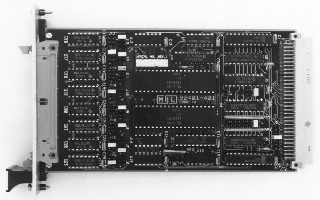VME401

VME 401 3U VME bus Serial Card
- Four Independent RS-422/RS-485 Compatible Channels A16:D8 Slave
- Multi-point Communication on each Channel
- RS-422 Drivers have Contention Protection
- Modem Control and Handshaking Lines
- Synchronous, Asynchronous, or SDLC/HDLC Operation
- Operates in Full or Half-Duplex Modes
- Data Rates up to 38.4 Kbps in Asynchronous Mode or 614 Kbps in Synchronous Mode
- Supports Vectored Interrupts
- 3U Form Factor
The VME401 Four Channel Serial Interface Card provides flexibility in applications requiring multiple RS-422 serial channels. Each serial channel can operate independently in full- or half-duplex mode with programmable data rates, parity word formats, interrupt vector, synchronous characters and modes of operation. Each RS-422 channel is RS-485 compatible and allows up to 32 driver-receiver pairs on a common data bus. The drivers and receivers for each channel may be enabled or disabled under software control. If two of the drivers are enabled simultaneously and a common mode voltage exists between the drivers, appreciable current can result in excessive power dissipation and possible driver destruction. The differential drivers used on the VME401 have contention protection to prevent such destruction. The common mode range is -7 volts to +12 volts with power on or off.
The card utilizes two 8530 Serial Communication Controller Chips (SCC's). The SCC provides serial to parallel and parallel to serial conversions by combining the features of a Serial Input/Output device and a digital phase-locked loop for clock recovery, baud rate generation, and NRZ, NRZI, and FM encoding/decoding. Each SCC provides two serial channels which operate independently in full- or half-duplex mode with programmable data rates parity, word formats, interrupt vectors, synchronous characters and modes of operation.
Asynchronous operation allows data rates up to 38.4 Kbps.
Synchronous operation allows data rates up to 614 Kbps and bit or byte oriented protocols, including Monosynchronous, Bisynchronous, HDLC and SDLC.
Programmable Array Logic circuits provide device selection, timing to the SCC, bus direction control, and interrupt handling.
Interrupts can be generated by the SCC devices and can be disabled under hardware or software control. The card can be configured to respond to one of seven VMEbus interrupt request levels and can supply vectored interrupts.
Operating in the short addressing range, the VME401 uses 18 (12H) consecutive I/O locations in the upper 64K of 68000 addressing and is mapped at a base address of F001H. Jumpers permit selecting the address at which the card is located and whether the card responds to the Supervisory access mode or to both Supervisory and Non-privileged access modes.
- Data Transfer: A16:D8
- Interrupt: Any One of Seven Priority Levels (IRQ1-IRQ7)
- Environmental
- Operating Temperature: 0 to 65°C
- Maximum Operating Humidity: 90% Non-Condensing
- Power Requirements: 975 mA Typical @ +5 VDC, 1.5A Maximum
- Physical Dimensions: 100 mm wide (3.9") by 160 mm long (6.3")
